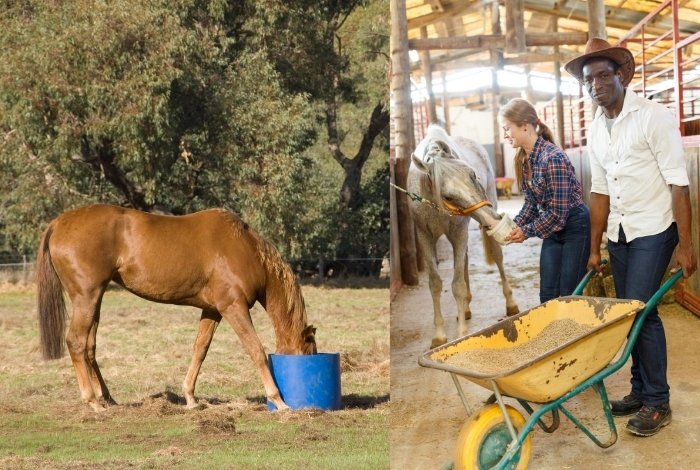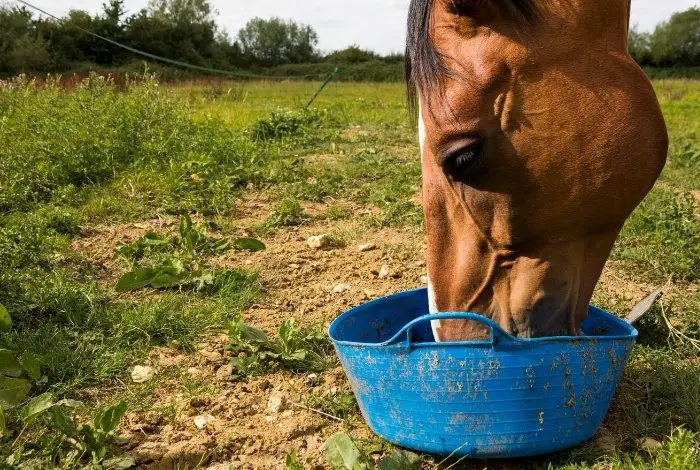Last Updated on December 26, 2022
Selenium is a trace mineral that is found in soil, and an essential micronutrient for horses. How can you tell if your horse is receiving enough selenium, and are there signs of a selenium deficiency in horses? Although horses only require an FDA recommended 3mg of selenium per day, many horses will require a supplemental source. Even though selenium is a naturally occurring mineral, some regions have micronutrient deficiencies in the soil. Unlike horses, humans have more options for selenium intake, including nuts, fish, some meats, and grains.
Role of Selenium in Horses
Horses need selenium for optimal cellular function. In conjunction with vitamin E, selenium acts as an antioxidant protecting healthy cells and maintains the proper circulation of thyroid hormones.

Oxidizing agents known as free radicals attack lipids, creating lipid peroxides. The antioxidants help protect from or prevent lipid peroxides from forming, and help prevent damage to cell function.
Selenium also boots a horse’s natural immune response. Although only small quantities are needed, selenium is essential.
Signs of Selenium Deficiency in Horses
Although symptoms can be far-ranging, there are distinct signs of selenium deficiencies. One of the most notable problems that can develop from a deficiency is white muscle disease. This is a degenerative disease that can affect multiple forms of livestock and their skeletal and cardiac muscles.
Foals and developing horses are more susceptible if their nursing mothers lack selenium. Foals with white muscle disease may develop fast heart rates, struggle to swallow or suckle, or have discolored dark urine.
Selenium deficiencies may also cause horses to “tie-up” due to rhabdomyolysis (frequently accompanied by dark urine).
Less severe but important symptoms include poor coat and hoof quality, muscle soreness, decreased performance, or decreased fertility.
Read more about Loose Minerals For Horses; Are They Necessary?
Correcting Selenium Deficiency in Horses
Selenium intake should be monitored, especially when supplementing specifically for this trace mineral. Extremely high doses of selenium will cause acute toxicity and possibly death, but these cases are very rare.
More commonly, horses lack selenium-rich forage due to soil conditions and require adding the mineral into their diets.
A deficiency can be diagnosed with a simple blood test by your veterinarian, and easily corrected with over-the-counter supplementation, feed, or different forage sources. Some manufacturers of salt and mineral blocks also produce blocks with added selenium. However, acute deficiencies may require injectable medication to instantly boost selenium levels.
Checking Your Resources
Most commercial feeds and grains contain small amounts of selenium. Regardless of whether you suspect a selenium deficiency, horse owners can test their soil and hay for micronutrients.
Although more common tests for forage include crude protein and acid detergent fibers, analysis of trace mineral content is also available. Some regions have known selenium deficiencies in their soil. However, areas like Montana, are known for selenium-rich soils. It’s no surprise that forage from these areas tends to have higher selenium levels than the national average for similar grass hays.
For more information on forage and soil testing, you can contact your local agriculture extension agency. Extension representatives and your local equine veterinarian are also good resources to help you better understand the nutrition breakdown on your commercial feed labels.
Supplementation
Due to the toxicity potential, selenium has been labeled as an environmental hazard despite the necessity for optimal cell function in horses. Therefore, there are government regulations on selenium content in commercial feeds. Luckily, there are multiple products on the market that can help add adequate amounts of selenium into horses’ diets. However, horse owners still need to be mindful of how much selenium is being supplemented. Most selenium supplements are accompanied by added vitamin E.

These are some of our top picks available on Amazon:
Products
Horse Health Vita E & Selenium Crumbles
- This formula includes vitamin E and selenium for optimal immune support and antioxidants. Vita E & Selenium Crumbles is available in a 3lb and 20lb (a 640-day supply!) and provides 1mg of selenium per half an ounce. This is a good option to monitor selenium intake by singular milligram in cases where the horse may already be consuming some selenium. This is yet another winning formula from the makers of Red Cell.
Also, find it in horseloverz.com
AniMed Vitamin E and Selenium
- If it can be supplemented, AniMed makes it! Their Vitamin E and Selenium comes in a 2.5lb or 5lb bucket, and also contains zinc. Each powder tablespoon of product contains approximately 625IU of vitamin E and 1.4mg of selenium. The powder is a great feed topper, or perfect for picky eaters when easily mixed with something enticing!
Also, find it in horseloverz.com
UltraCruz Equine Selenium Yeast
- The UltraCruz Equine Selenium Yeast supplement contains organically chelated selenium in powder or pelleted formula. Two manufacturer-recommended scoops of product contain 2.4mg of selenium. The powder formula is a simple no-fuss topper, and the pelleted formula is an alfalfa meal and flaxseed base.

Farnam Vita-Min E & Selenium
- Farnam delivers yet again! Vita-Min E & Selenium offers 625IU of vitamin E and 1mg of selenium per .5 oz serving. A modest 3lb bucket will last 96 days at the standard serving suggestion!
Final Words
Although the FDA recommended dosage of selenium for horses may seem small, selenium is a powerful necessity in your horse’s diet. It is important to examine feed, pasture, and added forage for selenium content.
If there is a suspected deficiency, contact your equine veterinarian for plasma, serum, or whole blood selenium level test. Likewise, if your horse is exhibiting dangerous symptoms of selenium toxicity, these tests can also reveal the current selenium measurements. Your local extension agent will also have information on known soil conditions of your region, which can provide a wealth of knowledge on micronutrient consumption in grazing horses.
Do you live in a selenium-rich or deficient area? Have you ever needed to have soil or forage testing done? Let us know what (or if) you’re supplementing, and be sure to share this article with your horse friends!
FAQs
Is Selenium deficiency common in horses?
Besides being an essential trace mineral in all mammals, selenium is especially important in equine species. It plays a vital role in the synthesis of protein, and it is an antioxidant that protects tissues from damage caused by free radicals. A deficiency of selenium can cause laminitis, colic, diarrhea, and other health problems in horses.
Selenium deficiency is a problem in horses all the time, regardless of the time of year. It is very common in young foals and young horses that are still growing. The main cause of selenium deficiency is inadequate dietary intake. The reason for this is that although selenium is an essential nutrient, it cannot be produced by the body on its own. So, horses need selenium in their diet.
How is selenium deficiency treated?
Selenium deficiency in horses is most often treated with supplements that contain this essential trace mineral. Selenium supplements are available in different forms and concentrations, and they are designed to meet the needs of individual horses. Most horses require 1 mg of selenium per day in form of supplements. Supplements can be mixed with the feed or administered as an injection. The injectable form of selenium is commercially available, and it is quite safe to use in horses.
Acute selenium deficiency can be treated with a selenium supplement called selenomethionine, which is available in injectable form. This medication is effective immediately and does not cause any side effects.
Oral supplementation is used after the injectable treatment is finished. This is done by mixing a daily oral dose of selenomethionine with the horse’s regular feed.
How do horses get selenium toxicity?
Even though selenium is a crucial element for cells protection, the horse will develop selenium toxicity if a his diet is supplemented with too much selenium. Selenium toxicity in horses normally expresses as alkali disease.
Alkali disease can affect horses and cattle. It causes the horse to start loosing hair from mane and tail, it can cause sloughing of hooves, joint erosion, and also lameness. Selenium toxicity can also provoke blindness, head pressing, and respiratory failure.
At what level is selenium toxic to horses?
According to the National Research Council, the minimum requirement for selenium in the feed of adult horses is 1 mg per day or 0.1 mg/kg of horse's feed. Selenium becomes toxic if the horse gets 2 mg/kg of feed or more.
Since the horse may never completely recover from the selenium poisoning, the owner should pay special attention to the mineral content of the feed that the horse is given. If the horse is fed a diet that is too high in minerals (especially potassium and phosphorus), then the horse will absorb more selenium from the supplements that are added to his feed. This can lead to a toxic accumulation of selenium in the body.
Selenium toxicity can be confirmed with a blood test or hoof, hair, or tissue sample. If selenium levels are higher than should be, a high protein feed should be given to a horse.
Equestrian, Marine Corps vet, and Morgan horse enthusiast.


